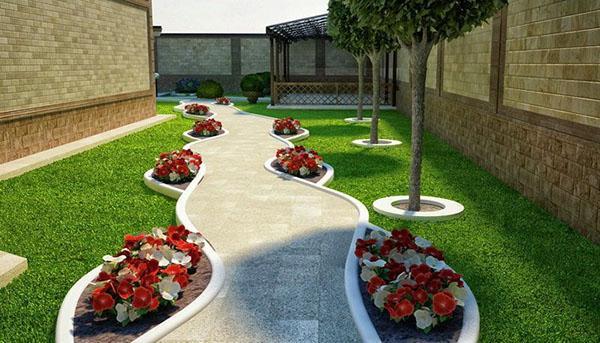How best to arrange a section of an elongated shape
 The elongated section design involves the use of diagonals. Such planning of the site allows you to visually expand it and give it a square, even shape. Using diagonal planning, you can achieve a tremendous effect: the area will appear two to three times larger. Let's look at the basic principles of diagonal planning for elongated narrow sections.
The elongated section design involves the use of diagonals. Such planning of the site allows you to visually expand it and give it a square, even shape. Using diagonal planning, you can achieve a tremendous effect: the area will appear two to three times larger. Let's look at the basic principles of diagonal planning for elongated narrow sections.
Zoning
First of all, it is necessary to divide the site into zones. These zones can be, for example, country playground, a vegetable garden, a flower garden, an outdoor cafe and a plot with outbuildings.
It is important to correctly plan the location of the zones relative to each other. It is better to equip a playground next to a recreation area near the house so that children are supervised.
Flower garden and the vegetable garden are usually combined, since these two zones equally require plant care. A summer cafe or a gazebo for a barbecue is placed near the kitchen, and a plot with outbuildings, on the contrary, is better planned away from a residential building and a playground.
Selecting the main diagonal guide
The so-called dry stream can be chosen as the main diagonal guide. The main diagonal must pass through all the marked areas of the lot. Also, a hedge is often made the main guide, dividing the site into two halves.
The main thing to remember when planning diagonally is: the main diagonal guide is the central emphasis on the site. Therefore, it must stand out.
Together with the main guide, there should be several secondary lines on the site. These can be diagonally planted plants or lightning-shaped curbs. It is not necessary to make the auxiliary diagonals perfectly straight, but they should not intersect with each other.
On the site, you can use not only diagonal shapes. Round flower beds go well with straight lines.
If you have chosen a dry stream as your main guideline, plant small-flowered plants and shrubs in it diagonally. This will highlight the main guide well.
Each zone of the plot must have at least two auxiliary diagonals. If the functional purpose of the zone does not provide for the presence of plants, then paths can be used as guide lines.
The zone with outbuildings is separated from the main part by a wooden arch so that it does not spoil the design of the site. You can plant a vine near the arch.
You should not close the area with outbuildings with a fence with a wicket, because you will create the feeling that the site has ended at the fence.